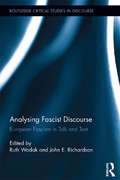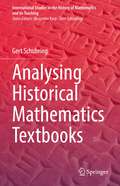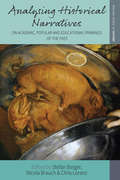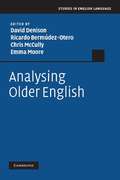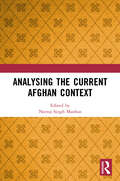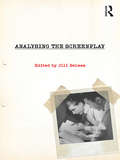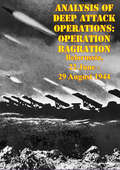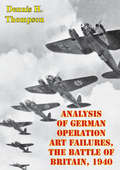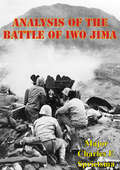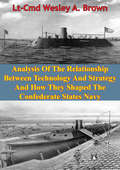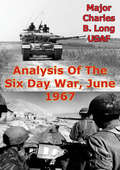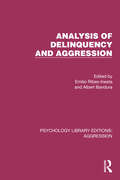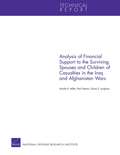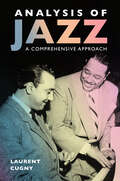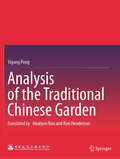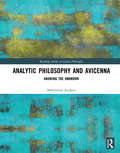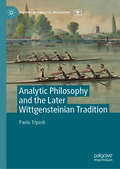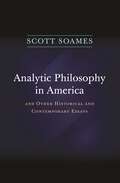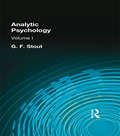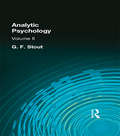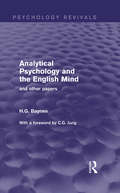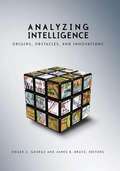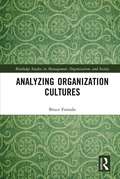- Table View
- List View
Analysing Fascist Discourse: European Fascism in Talk and Text (Routledge Critical Studies in Discourse #5)
by Ruth Wodak John E. RichardsonThis book focuses primarily on continuities and discontinuities of fascist politics as manifested in discourses of post-war European countries. Many traumatic pasts in Europe are linked to the experience of fascist and national-socialist regimes in the 20th century and to related colonial and imperialist expansionist politics. And yet we are again confronted with the emergence, rise and success of extreme right wing political movements, across Europe and beyond, which frequently draw on fascist and national-socialist ideologies, themes, idioms, arguments and lexical items. Post-war taboos have forced such parties, politicians and their electorate to frequently code their exclusionary fascist rhetoric. This collection shows that an interdisciplinary critical approach to fascist text and talk—subsuming all instances of meaning-making (oral, visual, written, sounds, etc.) and genres such as policy documents, speeches, school books, media reporting, posters, songs, logos and other symbols—is necessary to deconstruct exclusionary meanings and to confront their inegalitarian political projects.
Analysing Historical Mathematics Textbooks (International Studies in the History of Mathematics and its Teaching)
by Gert SchubringThis book is about the creation and production of textbooks for learning and teaching mathematics. It covers a period from Antiquity to Modern Times. The analysis begins by assessing principal cultures with a practice of mathematics. The tension between the role of the teacher and his oral mode, on the one hand, and the use of a written (printed) text, in their respective relation with the student, is one of the dimensions of the comparative analysis, conceived of as the ‘textbook triangle’. The changes in this tension with the introduction of the printing press are discussed. The book presents various national case studies (France, Germany, Italy) as well as analyses of the internationalisation of textbooks via transmission processes. As this topic has not been sufficiently explored in the literature, it will be very well received by scholars of mathematics education, mathematics teacher educators and anyone with an interest in the field.
Analysing Historical Narratives: On Academic, Popular and Educational Framings of the Past (Making Sense of History #40)
by Chris Lorenz Stefan Berger, Nicola BrauchFor all of the recent debates over the methods and theoretical underpinnings of the historical profession, scholars and laypeople alike still frequently think of history in terms of storytelling. Accordingly, historians and theorists have devoted much attention to how historical narratives work, illuminating the ways they can bind together events, shape an argument and lend support to ideology. From ancient Greece to modern-day bestsellers, the studies gathered here offer a wide-ranging analysis of the textual strategies used by historians. They show how in spite of the pursuit of truth and objectivity, the ways in which historians tell their stories are inevitably conditioned by their discursive contexts.
Analysing Historical Narratives: On Academic, Popular and Educational Framings of the Past (Making Sense of History #40)
by Chris Lorenz Stefan Berger, Nicola BrauchFor all of the recent debates over the methods and theoretical underpinnings of the historical profession, scholars and laypeople alike still frequently think of history in terms of storytelling. Accordingly, historians and theorists have devoted much attention to how historical narratives work, illuminating the ways they can bind together events, shape an argument and lend support to ideology. From ancient Greece to modern-day bestsellers, the studies gathered here offer a wide-ranging analysis of the textual strategies used by historians. They show how in spite of the pursuit of truth and objectivity, the ways in which historians tell their stories are inevitably conditioned by their discursive contexts.
Analysing Older English
by Chris Mccully Emma Moore Ricardo Bermúdez-Otero David DenisonIs historical linguistics different in principle from other linguistic research? This book addresses problems encountered in gathering and analysing data from early English, including the incomplete nature of the evidence and the dangers of misinterpretation or over-interpretation. Even so, gaps in the data can sometimes be filled. The volume brings together a team of leading English historical linguists who have encountered such issues first-hand, to discuss and suggest solutions to a range of problems in the phonology, syntax, dialectology and onomastics of older English. The topics extend widely over the history of English, chronologically and linguistically, and include Anglo-Saxon naming practices, the phonology of the alliterative line, computational measurement of dialect similarity, dialect levelling and enregisterment in late Modern English, stress-timing in English phonology and the syntax of Old and early Modern English. The book will be of particular interest to researchers and students in English historical linguistics.
Analysing the Current Afghan Context
by Neeraj Singh ManhasAfghanistan is on the verge of another transition as it seeks stability and deals with a variety of internal and external issues. After the Taliban, an Islamic fundamentalist organisation, captured Kabul, Afghanistan’s capital, on August 15, 2021. It was the culmination of a military offensive against the Afghan government that began in May 2021. The arrest occurred just hours after President Ashraf Ghani fled the country. The majority of Afghanistan’s provincial capitals had fallen one after the other as part of a US troop withdrawal scheduled to end on August 31, 2021. Internal political turmoil, constant Taliban attacks across the country, and deadly suicide bombings by the Islamic State-Khorasan keep it busy while external nations play the New Great Game for geo-strategic ambitions both in its front yard and in its backyard. This book highlights all the ongoing issues of Afghanistan’s surge and provides the readers with insights into the country’s past, present and future. Print edition not for sale in South Asia (India, Sri Lanka, Nepal, Bangladesh, Pakistan and Bhutan).
Analysing the Screenplay
by Jill NelmesMost producers and directors acknowledge the crucial role of the screenplay, yet the film script has received little academic attention until recently, even though the screenplay has been in existence since the end of the 19th century. Analysing the Screenplay highlights the screenplay as an important form in itself, as opposed to merely being the first stage of the production process. It explores a number of possible approaches to studying the screenplay, considering the depth and breadth of the subject area, including: the history and early development of the screenplay in the United States, France and Britain the process of screenplay writing and its peculiar relationship to film production the assumption that the screenplay is standardised in form and certain stories or styles are universal the range of writing outside the mainstream, from independent film to story ideas in Bhutanese film production to animation possible critical approaches to analysing the screenplay. Analysing the Screenplay is a comprehensive anthology, offering a global selection of contributions from internationally renowned, specialist authors. Together they provide readers with an insight into this fascinating yet complex written form. This anthology will be of interest to undergraduate and postgraduate students on a range of Film Studies courses, particularly those on scriptwriting.
Analysis Of Deep Attack Operations: Operation Bagration, Belorussia, 22 June - 29 August 1944 [Illustrated Edition]
by Lieutenant Colonel William M. ConnorIncludes the World War Two On The Eastern Front (1941-1945) Illustration Pack - 198 photos/illustrations and 46 maps.Operation BAGRATION took place during what the Soviet analysts consider the third period of the war: that of the Soviet strategic offensives which marked the ascendancy of the Soviet armed forces over the German Wehrmacht. During this period, the armed forces of the Soviet Union held the strategic initiative and used it to defeat the Wehrmacht, gain control of Eastern Europe, and invade Germany proper, meeting Allied forces on the Elbe River on 25 April 1945. The period is regarded as beginning Jan. 1944 and ending with the V-E Day, 7 May 1945.By the beginning of 1944, the Red Army clearly had the initiative on the Eastern Front; moreover, since the beginning of the second period, the Soviet Union also had strong allies who could provide assistance in two ways: the U.S. and Great Britain...The invasions of Sicily and Italy followed in the second period, knocking Italy out of its alliance with Germany and diverting German forces to defend in Italy. The invasion of Sicily may also have contributed to the German decision to break off its Kursk offensives as well in July 1943...In the third period of the war, therefore, the Soviet Union held the strategic initiative, and the year opened with the first two of what would come to be known as the "Ten Destructive Blows" of 1944: Leningrad and the Ukraine. The offensive at Leningrad commenced on 14 Jan. 1944 and ground to a halt on 1 March with the German siege of Leningrad broken, the German Sixteenth and Eighteenth Armies defeated, Soviet advances of up to 200 kilometers, and Soviet forces on the border of Estonia. The blow in the Ukraine commenced on 24 Jan. 1944, lasting until mid-April, and involved all of the fronts in the Ukraine. Finally, the various fronts were ordered by Stavka to go on the defensive between 17 April and 6 May to prepare for the summer offensive.
Analysis Of German Operation Art Failures, The Battle Of Britain, 1940
by Lieutenant Colonel John TurnerThe Battle of Britain was the first major defeat for the Germans of WWII. The Battle of Britain was an air operation designed to give Germany air superiority over both the English Channel and England. Gaining air superiority was considered by the Germany Army and Navy as absolutely essential prior to "Operation Sea Lion," the landing and invasion of England. Because the Luftwaffe was never able to establish the requisite air superiority, Sea Lion was cancelled.This paper examines the German Operational Art issues from a historical perspective. It concludes the failure of the Luftwaffe belongs to Reich-Marshall Goring, operational commander for the Battle of Britain. His main failure, as operational commander, was repeatedly making tactical decisions from the operational level rather than leaving this to on-the-scene tactical commanders. Secondly, he was never able to identify Fighter Command as the British Center of Gravity. Thirdly, he never understood the intelligence advantage gained by the British as a result of their newly invented radar early warning system. As a result, Germany lost the battle.
Analysis Of The Battle Of Iwo Jima
by Major Charles F. Sprietsma"Among Americans who served on Iwo Island, uncommon valor was a common virtue". This statement by Fleet Admiral Nimitz following the Battle of Iwo Jima succinctly summarizes the degree of effort, dedication, and personal sacrifice required of American servicemen to capture the island. The Japanese defenders also displayed these qualities, but the United States forces prevailed because they combined this effort, dedication, and sacrifice with superior application of basic principles of warfighting. Analysis of the application of these principles will help us understand why the battle developed and ended as it did. To do this, we must first examine the battle itself.
Analysis Of The Relationship Between Technology And Strategy And How They Shaped The Confederate States Navy [Illustrated Edition]
by Lt-Cmd Wesley A. BrownIncludes 23 illustrations and 3 tables.This study investigates the use of technology by the Confederate States of America to develop naval strategy and ultimately the Navy during the American Civil War. The study concentrates on the building and use of: ironclads to break the blockade and coastal defense, torpedoes (mines) for coastal defense, and Submarines to help break the blockade at Charleston.The use of technology had a significant influence on the Confederate Navy not only on the strategic, but also on the operational and the tactical levels of war. Operational campaigns were planned and executed around the presence or absence of confederate ironclads by both the North and the South. Battles were won, lost, or never fought due to the presence of confederate torpedoes laid in Southern harbors. The threat of Confederate submarines caused Union blockading squadrons to reduce the capabilities of catching runners by moving the fleet out of the submarines tactical range.Today's Navy, in its quest for new technology, faces a similar situation as the Confederate Navy did in 1861. The Navy must seek new technology to enhance warfighting skills and not simply look for the "ultimate weapon," as the Confederate Navy first thought of the ironclad.
Analysis Of The Six Day War, June 1967
by Major Charles B. Long USAFThis paper examines the Six Day War, the Arab-Israeli conflict of 1967, for the purposes of highlighting applications/violations of the principles of war outlined in AFM 1-1. This material will be incorporated into an AGSC block of instruction studying the principles of war as used in famous historical battles. This paper is divided into three separate sections. The first section reviews the background of the Arab-Israeli problem and highlights some of the major events leading up to the war. This section also presents a battle synopsis of the conflict including visual depictions of the battle progress. The second section provides an analysis of the use (or misuse) of the principles of war by each side--Arab and Israeli. The final section provides some discussion questions, with supporting rationale, in a guided discussion format for possible use in a seminar environment. The non-standard format for this project is at the request of ACSC/EDCJ to assist in building this particular block of instruction.
Analysis and Interpretation in the Exact Sciences: Essays in Honour of William Demopoulos (The Western Ontario Series in Philosophy of Science #78)
by Robert Disalle Melanie Frappier Derek BrownThe essays in this volume concern the points of intersection between analytic philosophy and the philosophy of the exact sciences. More precisely, it concern connections between knowledge in mathematics and the exact sciences, on the one hand, and the conceptual foundations of knowledge in general. Its guiding idea is that, in contemporary philosophy of science, there are profound problems of theoretical interpretation-- problems that transcend both the methodological concerns of general philosophy of science, and the technical concerns of philosophers of particular sciences. A fruitful approach to these problems combines the study of scientific detail with the kind of conceptual analysis that is characteristic of the modern analytic tradition. Such an approach is shared by these contributors: some primarily known as analytic philosophers, some as philosophers of science, but all deeply aware that the problems of analysis and interpretation link these fields together.
Analysis of Delinquency and Aggression (Psychology Library Editions: Aggression)
by Albert Bandura Emilio Ribes-InestaOriginally published in 1976, this volume is organized about two central themes: the experimental analysis of aggression, and the application of learning principles to the prevention and modification of delinquency. The chapters, all new and original at the time, demonstrate how the problems of aggression, which had been interpreted in diverse ways, can be analyzed under controlled laboratory conditions. In addition, the contributors offer an explanation of how behavior modification techniques, derived from this knowledge, can be used for preventive purposes.Because of the social nature of aggression and delinquency, behavior change techniques were principally aimed at modifying environmental influences. The contributions to this volume illustrate how behavioral scientists may aid in the understanding and amelioration of conditions that give rise to violence. Today it can be read and enjoyed in its historical context.
Analysis of Financial Support to the Surviving Spouses and Children of Casualties in the Iraq and Afghanistan Wars
by Paul Heaton David S. Loughran Amalia R. MillerExamines how the death of service members affects the subsequent labor market earnings of surviving spouses and the extent to which survivor benefits provided by the Department of Defense, the Department of Veterans Affairs, and the Social Security Administration compensate for lost household earnings. Also assesses the extent to which payments surviving spouses and children receive compensate for earnings losses attributable to combat death.
Analysis of Jazz: A Comprehensive Approach (American Made Music Series)
by Laurent CugnyAnalysis of Jazz: A Comprehensive Approach, originally published in French as Analyser le jazz, is available here in English for the first time. In this groundbreaking volume, Laurent Cugny examines and connects the theoretical and methodological processes that underlie all of jazz. Jazz in all its forms has been researched and analyzed by performers, scholars, and critics, and Analysis of Jazz is required reading for any serious study of jazz; but not just musicians and musicologists analyze jazz. All listeners are analysts to some extent. Listening is an active process; it may not involve questioning but it always involves remembering, comparing, and listening again. This book is for anyone who attentively listens to and wants to understand jazz. Divided into three parts, the book focuses on the work of jazz, analytical parameters, and analysis. In part one, Cugny aims at defining what a jazz work is precisely, offering suggestions based on the main features of definition and structure. Part two he dedicates to the analytical parameters of jazz in which a work is performed: harmony, rhythm, form, sound, and melody. Part three takes up the analysis of jazz itself, its history, issues of transcription, and the nature of improvised solos. In conclusion, Cugny addresses the issues of interpretation to reflect on the goals of analysis with regard to understanding the history of jazz and the different cultural backgrounds in which it takes place. Analysis of Jazz presents a detailed inventory of theoretical tools and issues necessary for understanding jazz.
Analysis of the Traditional Chinese Garden
by Yigang PengAnalysis of the Traditional Chinese Garden is a seminal resource for the spatial principles and techniques that shape traditional Chinese gardens. It is a richly illustrated resource for historians, theorists, garden designers, landscape architects, architects and anyone interested in the design of these world renowned gardens with 106 pages of hand-drawn sketches by the author that vividly portray the intricacies and subtleties of traditional Chinese gardens. The book is widely known in China as a primary text for analysis of the gardens and was recognized with the inaugural National Excellent Architectural Book Award in 1990 and, since its debut in China in 1986, has garnered immense popularity and acclaim with 50 reprints and a total print run of 150,000 copies.
Analytic Philosophy and Avicenna: Knowing the Unknown (Routledge Studies in Islamic Philosophy)
by Mohammad AzadpurThis work engages in a constructive, yet subtle, dialogue with the nuanced accounts of sensory intentionality and empirical knowledge offered by the Islamic philosopher Avicenna. This discourse has two main objectives: (1) providing an interpretation of Avicenna’s epistemology that avoids reading him as a precursor to British empiricists or as a full-fledged emanatist and (2) bringing light to the importance of Avicenna’s account of experience to relevant contemporary Anglo-American discussions in epistemology and metaphysics. These two objectives are interconnected. Anglo-American philosophy provides the framework for a novel reading of Avicenna on knowledge and reality, and the latter, in turn, contributes to adjusting some aspects of the former. Advancing the Avicennian perspective on contemporary analytic discourse, this volume is a key resource for researchers and students interested in comparative and analytic epistemology and metaphysics as well as Islamic philosophy.
Analytic Philosophy and the Later Wittgensteinian Tradition (History of Analytic Philosophy)
by Paolo TripodiThis book aims to explain the decline of the later Wittgensteinian tradition in analytic philosophy during the second half of the twentieth century. Throughout the 1950s, Oxford was the center of analytic philosophy and Wittgenstein – the later Wittgenstein – the most influential contemporary thinker within that philosophical tradition. Wittgenstein's methods and ideas were widely accepted, with everything seeming to point to the Wittgensteinian paradigm having a similar impact on the philosophical scenes of all English speaking countries. However, this was not to be the case. By the 1980s, albeit still important, Wittgenstein was considered as a somewhat marginal thinker. What occurred within the history of analytic philosophy to produce such a decline? This book expertly traces the early reception of Wittgenstein in the United States, the shift in the humanities to a tradition rooted in the natural sciences, and the economic crisis of the mid-1970s, to reveal the factors that contributed to the eventual hostility towards the later Wittgensteinian tradition.
Analytic Philosophy in America: And Other Historical and Contemporary Essays
by Scott SoamesIn this collection of recent and unpublished essays, leading analytic philosopher Scott Soames traces milestones in his field from its beginnings in Britain and Germany in the late nineteenth and early twentieth century, through its subsequent growth in the United States, up to its present as the world's most vigorous philosophical tradition. The central essay chronicles how analytic philosophy developed in the United States out of American pragmatism, the impact of European visitors and immigrants, the midcentury transformation of the Harvard philosophy department, and the rapid spread of the analytic approach that followed. Another essay explains the methodology guiding analytic philosophy, from the logicism of Frege and Russell through Wittgenstein's linguistic turn and Carnap's vision of replacing metaphysics with philosophy of science. Further essays review advances in logic and the philosophy of mathematics that laid the foundation for a rigorous, scientific study of language, meaning, and information. Other essays discuss W.V.O. Quine, David K. Lewis, Saul Kripke, the Frege-Russell analysis of quantification, Russell's attempt to eliminate sets with his "no class theory," and the Quine-Carnap dispute over meaning and ontology. The collection then turns to topics at the frontier of philosophy of language. The final essays, combining philosophy of language and law, advance a sophisticated originalist theory of interpretation and apply it to U.S. constitutional rulings about due process.
Analytic Psychology: Volume I
by G. F. StoutFirst published in 2002. Routledge is an imprint of Taylor & Francis, an informa company.
Analytic Psychology: Volume II
by G. F. StoutFirst published in 2002. Routledge is an imprint of Taylor & Francis, an informa company.
Analytical Psychology and the English Mind: And Other Papers (Psychology Revivals)
by H.G. BaynesOriginally published in 1950, the name of the late Dr H.G. Baynes was already well-known as a leading exponent of and translator of the writings of Professor C.G. Jung, as author and as psychotherapist. The essay which gives it title to this varied and interesting collection of writings, shows clearly Dr Baynes’s gift for illuminating a familiar subject with fresh insight drawn from his wide knowledge of the unconscious mind. He can make the unconscious real to us, and can convince us that myth and dream are expressions of vital problems of the human soul. The collection includes material to interest many types of reader, from The British Journal of Medical Psychology, from Folk-Lore, from The Society for Psychical Research. But perhaps most full of interest for the majority of readers are the first three chapters of an unfinished book – What It Is All About; here we find an admirable introduction, given with a wealth of illustration, to the main concepts of Professor Jung’s analytical psychology. Dr Baynes made Professor Jung’s thought his own, without loss of his own originality. He can touch with significance any subject on which he writes, whether it be the problem of the individual or the kindred problems of humanity.
Analyzing Intelligence: Origins, Obstacles, and Innovations
by Roger Z. George James B. BruceDrawing on the individual and collective experience of recognized intelligence experts and scholars in the field, Analyzing Intelligence provides the first comprehensive assessment of the state of intelligence analysis since 9/11. Its in-depth and balanced evaluation of more than fifty years of U. S. analysis includes a critique of why it has under-performed at times. It provides insights regarding the enduring obstacles as well as new challenges of analysis in the post-9/11 world, and suggests innovative ideas for improved analytical methods, training, and structured approaches. The book's six sections present a coherent plan for improving analysis. Early chapters examine how intelligence analysis has evolved since its origins in the mid-20th century, focusing on traditions, culture, successes, and failures. The middle sections examine how analysis supports the most senior national security and military policymakers and strategists, and how analysts must deal with the perennial challenges of collection, politicization, analytical bias, knowledge building and denial and deception. The final sections of the book propose new ways to address enduring issues in warning analysis, methodology (or "analytical tradecraft") and emerging analytic issues like homeland defense. The book suggests new forms of analytic collaboration in a global intelligence environment, and imperatives for the development of a new profession of intelligence analysis. Analyzing Intelligence is written for the national security expert who needs to understand the role of intelligence and its strengths and weaknesses. Practicing and future analysts will also find that its attention to the enduring challenges provides useful lessons-learned to guide their own efforts. The innovations section will provoke senior intelligence managers to consider major changes in the way analysis is currently organized and conducted, and the way that analysts are trained and perform.
Analyzing Organization Cultures (Routledge Studies in Management, Organizations and Society)
by Bruce FortadoCertain consultants argue leaders can quickly, easily, and considerably alter their organization cultures to improve performance. Conversely, field researchers have described situations where leaders could do little to alter the existing organization culture. Between these extreme positions, a spectrum of varying degrees of leader influence exists, and organizations fall at various places along this spectrum. This book presents five field studies dealing with team, service, and sales cultures where both expected and unexpected outcomes arose. In multiple instances, leaders hoped showing some employee appreciation would compensate for offering below market average wages. Several leadership groups were prospering based on cost cuts or increased sales. Those below often had their work intensified and they were experiencing greater stress. Eight paradoxical situations were uncovered and the interpretations of the participants were based in part on their personal work histories and the history of their current organization. In each case, evidence of employee informal organization and managerial operating cultures were documented. Analyzing Organization Cultures uses detailed case studies of five work organizations to offer a comparative approach to analyzing organizational culture. It shows the latest state of knowledge on the topic and will be of interest to researchers, academics, and students in the fields of organizational studies, management history, human resource management, and organizational theory.
